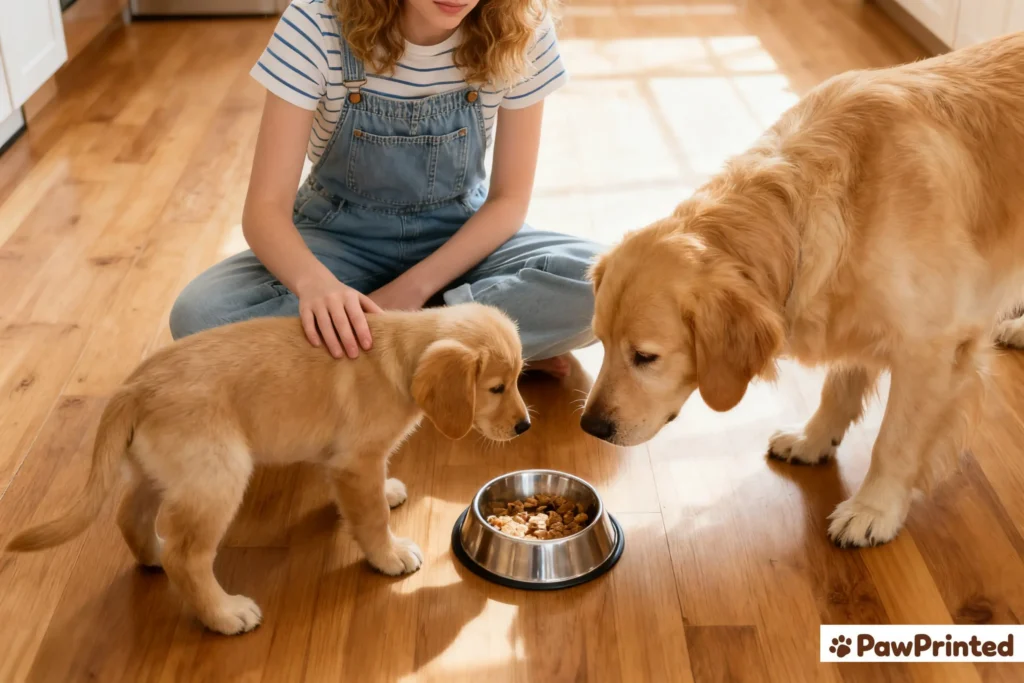Large breed puppies have big-dream skeletons that need time and the right nutrition to grow strong—think controlled energy, balanced calcium and phosphorus, and steady joint support. When we raised Ethan alongside our neighbors’ big-breed pups, one lesson stood out: large puppies shouldn’t grow fast; they should grow right. Here’s the vet-approved playbook and the foods that consistently worked for our big-pup friends.

Why Large Breed Puppies Need Different Food
Big frames are more vulnerable to skeletal stress. Diets for large-breed pups prioritize moderate energy density (to avoid rapid weight gain), controlled calcium-to-phosphorus ratios (for proper bone mineralization), and joint-friendly nutrients (glucosamine/chondroitin). DHA & EPA also support healthy brain and eye development.
What Worked for Ethan’s Big-Breed Friends (Our Shortlist)
On training days, the steady, balanced profile of Hill’s Science Diet Large Breed Puppy helped our neighbor’s Lab keep focus without turning snacky two hours later. For pups that needed irresistible palatability with size-specific nutrition, Royal Canin Large Puppy made mealtime automatic—no bowl coaxing required.
When availability mattered or we wanted more protein variety, Purina Pro Plan Large Breed Puppy (Chicken & Rice) was our dependable backup—easy to restock locally and consistent bag-to-bag. For families preferring gentle grains plus a chicken-first recipe, Blue Buffalo Large Breed Puppy (Chicken & Brown Rice) kept stools predictable during growth spurts.
Key Ingredients to Look For
- Moderate calories & controlled fat to avoid rapid growth and excess weight.
- Balanced Ca:P for healthy bone development in big frames.
- Glucosamine & Chondroitin to support hips, elbows, and shoulders.
- DHA & EPA for brain and vision during the first year.

Our Feeding Routine (Step by Step)
- Right size, right chart: use a large-breed puppy feeding chart as your baseline; adjust weekly by body condition.
- 2–3 meals/day: prevents overloading single meals and eases skeletal stress.
- Measure precisely: a scoop or kitchen scale beats eyeballing—growth is won gram by gram.
- Transition slowly (7 days): 25% → 50% → 75% → 100%, watching stools, appetite, and energy.
Quick Comparison (Top Large-Breed Puppy Foods)
| Option | Why It Helps | Best For |
|---|---|---|
| Hill’s Science Diet Large Breed Puppy | Controlled energy + balanced minerals; consistent, vet-trusted growth. | Everyday reliable pick; routine training schedules |
| Royal Canin Large Puppy | Size-specific nutrition and palatability; supports steady skeletal development. | Picky eaters that need big-breed precision |
| Purina Pro Plan Large Breed Puppy (Chicken & Rice) | Widely available; dependable protein-to-calorie balance for growth. | Families who need easy local restocks |
| Blue Buffalo Large Breed Puppy (Chicken & Brown Rice) | Chicken-first with gentle grains; stool predictability through growth spurts. | Sensitive tummies needing steady digestion |

FAQ
Do large breed puppies really need special food?
Yes. Big frames benefit from controlled energy and balanced minerals to protect developing bones and joints.
How do I prevent joint issues in large breed puppies?
Keep growth steady, feed a large-breed puppy formula, and maintain lean body condition. Avoid high-impact jumps while growth plates mature.
Can I feed regular puppy food to a large breed puppy?
It’s safer to choose large-breed puppy formulas designed for controlled growth and proper Ca:P balance.
When should I switch from puppy to adult large-breed food?
Typically around 12–18 months, depending on breed. Confirm timing and body condition targets with your vet.
If you don’t want to cook daily, check our dry food picks — those were Ethan’s daily backups.
Wrapping It Up: Large-breed puppies thrive on slow, steady growth. Start with one balanced formula, measure portions precisely, and monitor body condition rather than just the scale.
Follow PawPrinted On Pinterest
“See large-breed growth tips, feeding routines, and joint-friendly play ideas we test with Ethan and friends.”.


